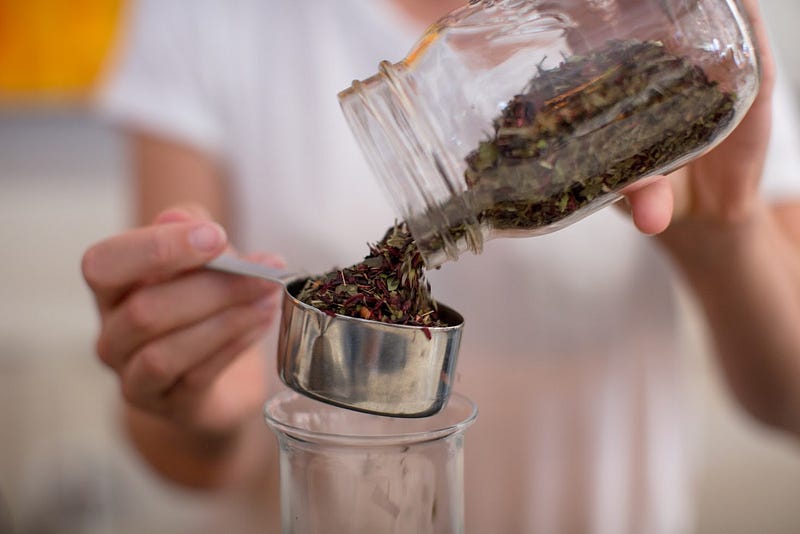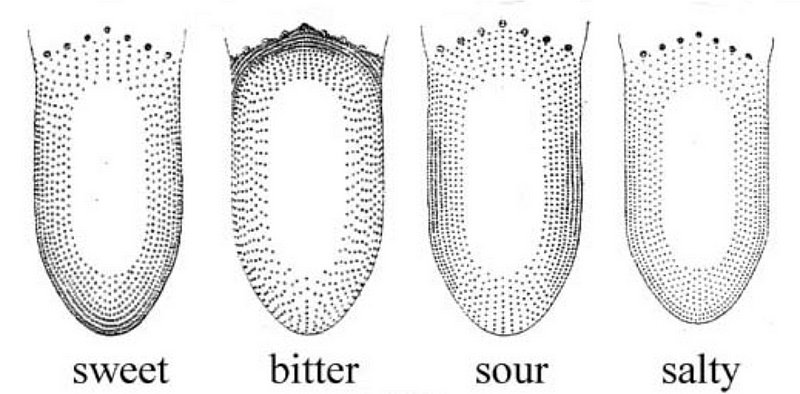The insula in our brain remembers and identifies flavor through Olfaction (smelling), Taste (chemicals perceived by taste buds) and Chemesthesis (trigeminal nerve response to food sensations). We require information from all 3 of these areas in order to determine the “flavor” of what we are tasting. Is that vanilla or chocolate? Should I consume more of this food/drink or should I stop immediately? Below we examine some of the science behind tasting. In a future article, we’ll delve into the science of olfaction.
Taste Buds
You might remember learning about the taste buds and a tongue map in grade school. We learned about bitter, salty, sweet and sour and we were told where on the tongue we sensed each of these elements. In truth, the tongue map we were taught was a misinterpretation of a 1901 experiment that was illustrated by Hanig. The so-called tongue map also did not include umami, the savory taste bud.
What Hanig’s experiment actually showed, was that all of these taste buds can be sensed in all areas of the tongue except the center, and that there are higher percentages of specific taste buds in certain areas of the mouth. As you can see in the illustrations below, sweet taste buds are in higher concentration at the front of the tongue, but sweet can be tasted all over the tongue (minus the center). The same is true for all the other taste buds.
Taste is detected by taste buds in the oral cavity. As infants, this is our natural defense protection and seeker of nutrients. Average adults have 10,000 taste buds. Taste bud sensitivity decreases as the day progresses, as we age, with oral infections, gastric reflux, scalding, smoking, illness (diabetes), drugs, pesticides, metal exposure, head trauma, surgical procedures and radiation. Furthermore, ancestry and genetics plays a big part as to how well you can taste.
Our taste buds can only pick up sweet, salty, sour, bitter and umami. So when we say “This tastes like an orange,” we are not technically correct. In actuality, we do not taste orange — we smell orange (we will discuss this more in the next issue). But our tongue does pick up on identifying the sweet-sour-bitter combination our brain associates with oranges.
Taste Buds and Tea
- Sweet is derived from carbohydrates found in tea of both mono and di saccharides. The withering step in the tea process helps determine sweetness. White teas are known for their natural sweetness. In green tea, the sweetness is derived from the polyphenol compounds of catechins like EGCG.
- Salty comes from the more than 25 different mineral elements that can be found in teas. This is based on the soil and weather conditions in the area. Wuyi Rock Oolongs are highly prized for their high mineral flavor due to the rocky soil.
- Bitter comes from alkaloids of the methxanthine family, most notably caffeine, theophylline, and theobromine found in all teas. In black teas, bitterness can also come from polyphenol compounds like theorubigins and theoflavins. Note: A recent study showed that an estimated 50% of the US population is missing or has an inactive taste bud for bitter. In our research, we found that those who tend to like green tea’s flavor, have this inactive bitter taste bud.
- Umami, which is referred to as the savory taste bud, can be easily tasted in aged cheeses like parmesan or in meat broths. In tea, umami comes from the 26 amino acids found in tea, most predominately L-theanine.
- Sour is not something commonly found in teas, with the exception of Darjeeling teas, due to its unique climate and processing. If teas have a sour taste, it is usually due to poorly maintained equipment or tea stored in the refrigerator overnight.
Chemesthesis
This is a nerve response to chemicals in foods and drinks by the trigeminal and vagus nerves. In flavor, it is most pronounced on the lips, nasal cavity, and the center of the tongue. These senses are buried below the surface of the tissue, thus a slow onset but long lasting. Examples of this nerve response could be: the fizzy tingle of soft drinks, burn of hot peppers, pungency of mustard or the bite of a raw onion.
The trigeminal nerve is also responsible for waking us up in the morning, helping with visual stimuli, coordinating movement, and helping with memory of physical activity. This is why it is important to associate flavor with visual memories when learning to become a better taster. This helps a taster recall flavors quicker and faster and to store more flavors in our flavor map.
These neurons outnumber taste buds 3 to 1 and are broken out into 4 categories. The Mechanoreceptor is responsible for the texture of the food. Thermoreceptor is for both real and perceived temperature. Real temperature as in iced or hot tea. But the coolness of mint or the hotness of peppers are a perceived temperature. Propriocepter tells use the motion and location of the food or drink in our mouth. And finally, Nociceptor is the pain sensation we get from chemicals like menthol in mints or capsaicin in peppers.
When it comes to tea, there is little chemesthesis activity with the major exception of astringency. Astringency, which is a mouth feel and not a taste, comes from the polyphenols in tea. However, there are sponge like proteins naturally found in saliva that can affect the perception of astringency. Furthermore, people differ in the concentration of this protein which changes throughout the day.
Our taste buds and nerve responses (chemesthesis) are 2 of the 3 pillars we need in order to define the flavors in the foods and beverages we consume. The third is olfaction. In part 2 we will discuss how olfaction plays it’s part.



